Abstract
Recently, the Senegalese people have learned to speak more openly of their history. But, as late as the 1980s—the years of my youth and early schooling—the wounds of colonialism were still fresh. I contend that slavery had been so powerful a blow to the Senegalese ethos that we—my family, friends, and schoolmates—did not speak about it. The collective trauma and shame of slavery was apparently so powerful that we sought to repress it, keeping it hidden from ourselves. We were surrounded by its evidence, but chose not to see it. Such was my childhood experience. As an adult, I understand that repression never heals wounds. The trauma remains as a haunting presence. But one can discover its “living presence,” should one choose to look. Just 5.2 km off the west African coast of Senegal lies Gorée Island, where millions of Africans were held captive while awaiting transport into slavery. Much of the four-century history of the African slave trade passed through Senegal, where I grew up. In this essay, I explore the history of the island and its role in the slave trade. I describe my own coming to terms with this history—how it has haunted me since my youth. And I argue for the role of visual rhetorics in the formation (and affirmation) of Senegalese ethos. As Baumlin and Meyer (2018) remind us, we need to speak, in order to be heard, in order to be seen: Such is an assumption of rhetorical ethos. And the reverse, as I shall argue, may be true, too: Sometimes we need to see (or be seen), in order to know what to speak and how to be heard. It is for this reason that we need more films written, directed, produced, and performed by Africans (Senegalese especially).
1. Introduction
Ethos is created when writers locate themselves.—Nedra Reynolds, “Ethos as Location” (Reynolds 1993, p. 336)
A person has a past. The experiences gathered during one’s life are a part of today as well as yesterday. Memory exists in the nostrils and the hands, not only in the mind. A fragrance drifts by, and a memory is evoked. It damages people to rob them of their past and deny their memories, or to mock their fears and worries. A person without a past is incomplete.—Eric J. Cassel, “The Nature of Suffering” (Cassel 1982, p. 642)
The following is an exercise in the ethos of storytelling. In the epigraph above, what Cassel writes about the individual can be said collectively of a people: the Senegalese, in my case. Much like a person, a people “without a past is,” as Cassel implies, “incomplete.” We can go further and state that much of that past—or shall I say, much of the past that matters—is recorded in story. In this essay, I will be practicing a form of “scholarship of the personal,” a hybrid genre that conjoins historical-cultural analysis with personal narrative.
I shall be telling the story of my coming to terms with a sad chapter in Senegalese history: specifically, the African slave trade, how I learned about it, and how my understanding of it—as well as of myself as Senegalese—has evolved. My own ethos is defined, in large part, by the collective memory of slavery imposed upon Africans. And I shall be focusing on a specific place where this slavery was imposed: Gorée Island, whose House of Slaves led to the Door of No Return. (See Figure 1) For “Ethos,” as Nedra Renolds writes above, “is created when writers locate themselves.” Ethos, in other words, adheres to places as well as to people. If “a person without a past is incomplete,” then I would add that a person’s “past” is inconceivable without a “place.” The places of one’s wounding—individually and collectively, historically and contemporaneously—are infused with the actions and adhere to the victims both in body and in memory.
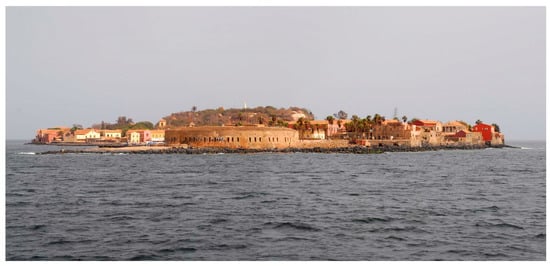
Figure 1.
Ile Gorée, Senegal. Creative Commons (photo by Antonin Rémond).
Unless my readers are African or otherwise well-educated, I doubt that they will know much about the history that I will be recounting; or they may know the story through other, likely Eurocentric texts. Some readers may not know where Senegal is. (“It’s in Africa, right?” But do not ask them where in Africa). Many will know something of the African slave trade, but not of my nation’s role in it; even if they know of Senegal, they are not likely to know of the specific place that I shall be describing (see Figure 2). I confess that, in my youth, even I did not know the whole story. In my adulthood, I know that story—and myself—better. Indeed, I know myself through the story.
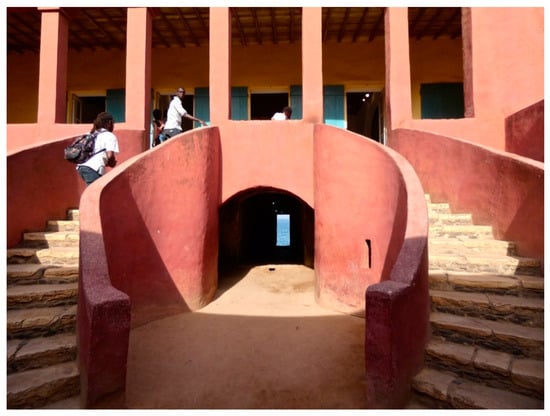
Figure 2.
The House of Slaves (la Maison des Esclaves), Gorée Island. Wikimedia Commons (photo by John Crane). Note the “Door of No Return” in the lower level.
I need to add, however, that it is not the story but the image of a doorway that haunts my personal experience of growing up Senegalese. This essay is not about storytelling in words alone. It is about the confluence of verbal and visual rhetorics—of the ways that the African slave trade “dwells” in places visualized as well as in language and memory. Popular media is implicated in this unleashing of the story of Gorée Island. While popular media like films and poster advertising (even advertising as a government-sponsored public service) “give visual presence” to the place I shall be discussing, these are not, in themselves, transparent mediums of communication. They introduce their own distortions, prejudices, idealizations, and partial truths. I shall argue that, yes, visual images have an important role to play in introducing the slave trade to contemporary audiences (African and non-African alike); but these need the supplement of texts. Most important, of course, is to visit the place: to bear witness to it, seeing and feeling it for oneself.
2. Failing to See
Seeing is of course very much a matter of verbalization. Unless I call my attention to what passes before my eyes, I simply will not see it. It is, as Ruskin says, “not merely unnoticed, but in the full, clear sense of the word, unseen.”—Annie Dillard, Pilgrim at Tinker Creek (Dillard 1974, p. 33)
I was twelve at the time, attending École Neuve Algor Dioum in Diourbel, an inland city some 150 km east of Dakar. I was in the last station of primary cycle in the history programme, in a class taught by Mr. Hanne. In his class, I learned that Africans were kidnapped—stolen from their homelands—and sold into slavery. From the 15th through to the 19th century, captives were taken from across sub-Saharan Africa; and Dakar in Senegal, the west African nation where I was born and raised, was one of the main ports of transit where captives were brought, bought, and shipped off to the Americas. That was the substance of Mr. Hanne’s lecture. As he spoke, I could feel the whole class gasp and exhale. Shame mingled with our surprise. Our questions were typical of twelve-year-old boys: “But how could a person be sold in exchange for a rifle or a mirror?” “How could our ancestors have been so weak to be treated this way?” I left class in a daze.
No other piece of information would ever shake me the way that did, changing my view of the world forever. And yet, after his lecture, I do not remember speaking about it; not to my schoolmates, not to my friends, not to my family. Borne in part of confusion but also of shame, that silence on my part seems to reflect a similar reticence on the part of my culture at that time—as if the wound were too big and it were best not to talk about it.
Two years later, I had a chance to go on a group trip to Gorée Island. Lying some 5.2 km west of Dakar, Gorée Island was the largest slave-trading centre on the African coast, containing such monuments as the House of Slaves and the infamous Door of No Return. Our brief visit was not meant to be educational so much as it was a school “merit badge,” a way of saying “we’ve been there.” We had not even registered for a proper tour of the House1. I enjoyed the ferry ride but the place—not so much. Being claustrophobic, I had an excuse for not entering the narrow passages leading to low-ceilinged prisoners’ cells (see Figure 3). I did not want to know that as many as twenty human beings were stuffed into rooms twelve metres deep and twelve metres wide, not knowing where they were going and what was happening to them (N’diaye 2006). Just glancing into them made my blood freeze. Even today, I can still feel the sensations of suffocation. As for the Door, it seemed like a portal to a black hole in space, leading nowhere (see Figure 4). Two years earlier, I did not want to hear about it (or talk about it); now, apparently, I did not want to see it.
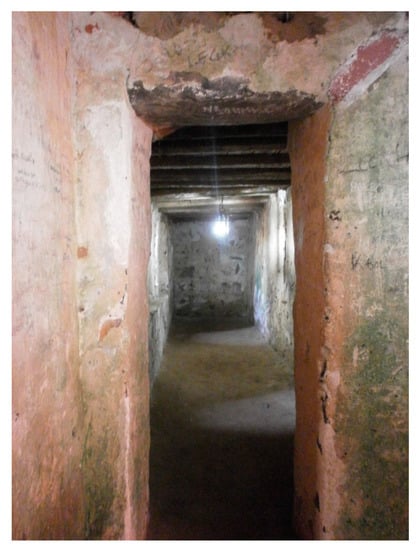
Figure 3.
Passageway to Prisoners’ Cells (Cellules, Maison des Esclaves). Wikimedia Commons (photo by HaguardDuNord).
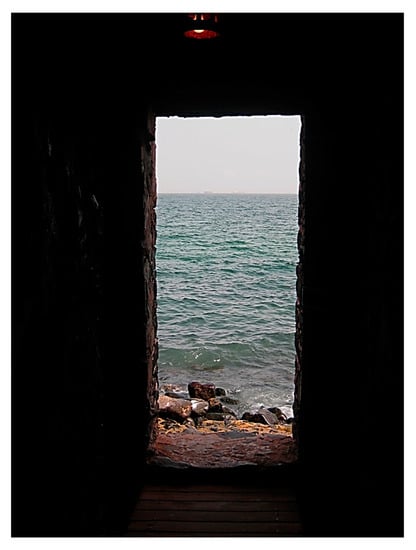
Figure 4.
“The Door of No Return” (La Porte du Non Retour de la Maison des Esclaves). Wikimedia Commons (photo by Wandering Angel).
When I was twenty, I left Senegal; that was in 1998. For the next ten years, I lived in France. It is curious how living elsewhere allows one to see one’s home place differently. I tell my students (yes, I teach now) that it was at a public exhibition in Nancy, France, that I learned how large a rhinoceros is and how tall a giraffe can be. Did I have to leave Africa in order to see it? (It is almost as if we are blinded and numb to the everyday world: In order to see truly, we have to see differently.) During those ten years spent in France, I returned to Senegal three times, each for very short periods. And during none of those brief visits did I feel the need to go back to Gorée Island.
From France, I moved to Canada. Once in Québec, I took another ten years before going back home to visit family. I also took advantage of that time to teach at Cesti, the journalism section of Dakar’s Université Cheikh Anta Diop. This was of great symbolic importance to me, since I was returning to Senegal as a teacher after having left twenty years before as a student. I would not have the time to go to Gorée Island and visit the House with “fresh,” informed eyes, but I had learned more of the history in the meantime and was able to share my impressions with colleagues and students2. And I knew my task, though the moment was not yet right: As an adult, I would need to revisit the House of Slaves and its Door of no Return. But I know something now that I could never have guessed back then: Wherever I have studied, worked, and taught, I have brought the House of Slaves with me unconsciously; and, in my dreamwork, I have stood at the Door of No Return. What I tried not to see or speak about has, in fact, haunted me since childhood.
I have my doctorate now. Currently, I teach linguistics, communication, and discourse analysis at Bishop’s University and Université de Sherbrooke in Quebec, Canada. Inside, though, I am still that young Senegalese student feeling himself shaken to the core by the lessons of history. And I think back to my initial feelings regarding Mr. Hanne’s lecture on the slave trade, which were not so much of outrage as of disbelief—of confusion that turns to anger and leads, curiously, to feelings of shame. And the questions that arose in the twelve-year-old me still rise, today: How could a proud people allow themselves to be enslaved? The trauma that I personally suffered in the hearing of that story—and it is one shared by many Africans today—remains tied to self-esteem. How to overcome the inferiority complex imposed by white colonialism? How to recover self-esteem? These are questions for a person, a community, a nation, a continent.
The so-called “civilized” countries that participated in the slave trade find it convenient to forget, too. They prospered off of African wealth in all respects: human, animal, agricultural, mineral and, yes, cultural. Today, their prosperity continues, while the African continent lags so far behind. Colonialism and even the sad episode of slavery is not all that far in the past; in fact, these remain linked to the continent’s current challenges. Yes, Africans are owed compensation, but economics alone cannot heal their wounds. African history, I have learned, is a series of atrocities and traumas. Physically, emotionally, psychologically, my ancestors endured much. And, having heard Mr. Hanne’s history lesson, the trauma of slavery became my own—though it was in self-image that I suffered the wound. The color of my skin had not changed, but the way I experienced that color changed, knowing what white Europeans did to black Africans.
3. Learning to See Better
[W]e presume that specific life-events—traumas for the most part—play constitutive roles in identity-formation. The abused spouse lives within an event and a narrative of that event: the abuse becomes thematic within that person’s self-image and life-story…. A further corollary to postclassical ethos … is the need to tell one’s story, particularly those aspects that bear wounds. Indeed, the highest aim of ethotic discourse is, or ought to be, to share one’s story; and, with respect to one’s functioning as audience, the highest corresponding aim is to bear witness to that other’s story.—James S. Baumlin and Craig A. Meyer, “Positioning Ethos” (Baumlin and Meyer 2018, p. 17)
I know that the atrocities of the so-called New World’s European colonizers did not stop with the enslavement of Africans. The sufferings of indigenous peoples throughout North and South America, Central America, and the Caribbean are reflected in my own people’s history, too. Included in this special issue, Craig A. Meyer’s essay, “From Wounded Knee to Sacred Circles: Oglala Lakota Ethos as ‘Haunt’ and ‘Wound’” (2018) gave inspiration—and a model—for my own narrative scholarship. The following paragraph, for example, is mine now, but it was taken from Meyer’s essay and rewritten, with the Native American vocabulary overlaid by Senegalese:
To understand Senegalese ethos today, one must understand the importance of the experience of the African slave trade, which extends to the visuals, the emotions, the memories of place—that is, to the entire experience (Fixico 2003, p. 22). It is the mythos of Gorée Island and the House of Slaves that we must seek to understand. For the European bystander, it is easy to dismiss the slave trade as having happened over 100 years ago to some group at some place; it is markedly different if one’s cultural identity rests in a continual retelling—in effect, a reliving—of colonialism. As Donald L. Fixico writes, “When retold, the experience comes alive again, recreating the experience by evoking the emotions of listeners, transcending past-present-future. Time does not imprison the story” (Fixico 2003, p. 22). The telling of these stories forms an integral part of Senegalese ethos, both as-haunt and as-wound.3
And this, too, is my paragraph now, though Meyer’s text lurks beneath it like a palimpsest:
Both the place and the events of the slave trade haunt the Senegalese cultural memory, which rests in the collective experience of trauma and the place—the physical haunt—of its occurrence. As such, a Senegalese ethos derives from haunt and wound. Ethos-as-haunt demonstrates how location constitutes a people, its culture, traditions, stories, and history…. Simply put, the events that occur on a parcel of land lends it character to the people of that land…. With this summary of the slave trade as a starting point, I turn now to review the Western model of ethos and its potential as haunt. From this understanding of location…. I suggest a bridge between haunt and wound as it relates to a Senegalese ethos and the hopeful healing that can take place through an acknowledgement of that woundedness. The conclusion offers insight into Senegalese wisdom for the Westernized humanities and the possibility of healing the wound from two different perspectives: European and African.4
As I read Meyer’s account of the Massacre at Wounded Knee, other massacres—at Soweto and at Thiaroye—came to mind: As much as the slave trade, these have come to define my sense of the “woundedness” of the African continent generally. Yet my mind wandered first to Jallianwala Bagh, also known as the Amritsar massacre. On 13 April 1919, Brigadier-General Reginald Dyer ordered troops of the British Indian Army to fire their rifles into a crowd of unarmed civilians in Jallianwala Bagh, killing at least 400, including forty-one children (Lloyd 2011). Curiously, I would not have known of the Amritsar massacre had I not seen the 1981 film Gandhi (Attenborough 1982), a British-Indian co-production starring Ben Kingsley.
I do not remember how old I was when I first saw Gandhi. I do remember very well this next nationwide media event; I believe it showed on Senegalese television in 1986 and, at the time of its showing, it thrust the slave trade back momentarily into the national consciousness. I am talking about the American TV miniseries, Roots (Chomsky 1977), based on the novel by Haley (1976). The novel combines two stories. The first is of Kunta Kinte, who was kidnapped in The Gambia (a country neighboring Senegal) in 1767 and sold as a slave in the British colony of Maryland. The second is of the character of the novelist himself, who—inspired by his grandmother’s stories—spent twelve years researching his ancestry. His search led him back to Africa, to the Gambian village of Juffure5. There, the griot or tribal storyteller recounted the village history, which confirmed to the author that he was, in fact, great-great-great-great grandson of Kunta Kinte. The novel was published in 1976; the miniseries aired in the U.S. in 1977. It took nearly a decade to reach Senegalese viewers. What I remember is that Senegalese national television had had serious apprehensions during the airing of this TV series, as white people living in Senegal were being subjected to threats. Through a largely fictional portrayal, the history of the Senegambian wound had been retold and the sense of woundedness awakened. When history contains powder kegs, a government or group can try to hide them; eventually they will be found, and they will explode.
There is a lesson in this. Several times throughout their essay, “Positioning Ethos,” Baumlin and Meyer describe reading and hearing synesthetically, as a means of seeing. For example: “The first step in healing ourselves, individually and collectively, is to unleash the self-expressive power of our storytelling: in effect, to make an appeal in good faith for a witness, in order ‘to be seen’ in our texts” (Baumlin and Meyer 2018, “Positioning,” p. 19). One speaks, not just to be heard, but to be seen: By this means, one’s ethos or self-image is “made present.” I do not disagree with their rhetorical model. What I am learning is that the image, at times, must “speak first,” in order to “give presence” to history. Visual media—film especially—has become the privileged mode of storytelling in contemporary world culture. What genuinely surprises me is that the textbook histories that I have learned (and even taught) rarely came fully to life for me until I saw them mirrored in art. As with the exhibition in French Nancy (where I saw, “as if” fully for the first time, an African rhinoceros and giraffe), the mediated “framing” of objects, places, and events allows us to see them better—or, at least, to see them differently—and respond to them accordingly.
When I was a student in Diourbel, “Apartheid est un crime contre l’humanité” was written at the top of the chalk board of every classroom. “Soweto” used to ring in our ears as a cursed word. But it was only in 2003, long after I had left Africa, that I first watched the American film, Cry Freedom (Attenborough 1987)—which carved indelibly into my mind the images of the carnage that met black schoolchildren in apartheid South Africa. In June 1976, reacting to the imposition of Afrikaans as the language of instruction in local schools, children poured into the streets of Soweto in protest. (As a linguist by training, I can attest to the role of language in creating ethos, both individually and collectively.) There, they were met with fierce police brutality. The facts have been blurred, perhaps deliberately, but somewhere between 176 and 700 children were killed (Brown 2016).
Yet another massacre strikes closer to home, having occurred in Senegal during French colonial occupation. It took place in 1944 at the military camp of Thiaroye, a small village in the suburbs of Dakar. A group of Senegalese Tirailleurs were protesting to be paid for their military service. Mind you, they were among the African soldiers who had fought for the French Free Army in France, seeking its liberation from Nazi Germany. Against their protests, the French colonial troops responded with bullets. According to “official” records, between thirty-five and seventy Tirailleurs were gathered together in camp and gunned down; witnesses give a higher number, reporting more than 300 Senegalese deaths (Mourre 2017).
When I was growing up, no one talked about Thiaroye. The massacre took place on the first of December, which so happens to be the day in which I am penning this paper. As I write, what surprises me is the seeming lack of interest shown by the postcolonial Senegalese government; it is as if they wanted to forget. The French government’s lack of interest is not surprising; in fact, the French did their best to ignore, deflect, deny. The general public did not learn of this massacre until 1988, when Senegalese Cineaste released Sembène Ousmane’s film, Camp de Thiaroye (Sembène 1988). The film was immediately banned in France and remained so for seventeen years, until becoming available on DVD in 2005. Here, indeed, we see why we need more films written, directed, produced, and performed by Africans (Senegalese especially). Again, as Baumlin and Meyer (2018) remind us, we need to speak, in order to be heard, in order to be seen: Such is an assumption of rhetorical ethos. And the reverse may be true, too: Sometimes we need to see (or be seen), in order to know what to speak and how to be heard. (See Figure 5)
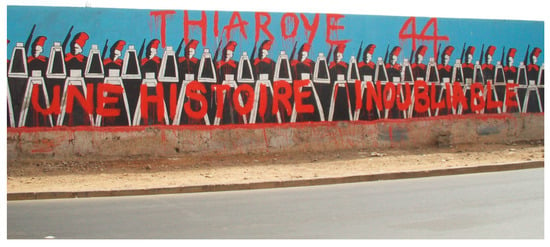
Figure 5.
“Thiaroye 44: Une Histoire Inoubliable.” Street Mural in Dakar. Wikimedia Commons (photo by Erica Kowal).
What is an individual or a social group made of? A common history and culture of course. But we should also add the impact of place, not just upon history and culture, but upon language. As a linguist, I study the cultural and psychosocial impact of naming. We could mention the classic example of the Inuits, whose language contains so many words for “snow.” Since snow defines their world, of course they have names for its various qualities and conditions. Put simply, their language reflects their environment: They need those different words. Similarly, the Touareg living in the Sahara Desert have a broad vocabulary to describe the types of sands that surround them. Wolof, the vernacular language of Senegal, has similar examples. In wolof, the term sedd (cold) is used to qualify someone or something welcoming and attractive, while tang (hot) would qualify a person, voice, or attitude that is unwelcoming or unattractive. In many Western cultures, these terms are reversed, where cold is unwelcoming while hot is attractive. Now, let us add geography to language: In tropical countries like Senegal, one longs for coolness, whereas people in Northern climates might long for heat. The places we live in have an impact on our words, which function as a means “to see” the world. The world needs our words in order to be seen, and our words invoke the world as an instrument of seeing.
The above may hold for objects and events outside of us, but what of the memories and mental images that inhabit our psychic spaces? How do we “give voice” to these, making them present to consciousness? In other words: How do we name the wounds that we have repressed, whether individually or as a culture?
4. Connecting Words, Images, Memories
The mythic seeks instead to unite, to synthesize, to assert wholeness in multiple or contrasting choices and interpretations. Mythos thus offers a synthetic and analogical, as opposed to analytic, mode of proof, one that discovers—indeed, celebrates—the diversity of truth.—James S. Baumlin and Tita French Baumlin, “On the Psychology of the Pisteis” (Baumlin and Baumlin 1994, p. 106)
I never knew how deeply the slave trade had settled into my subconscious until I came across a poster image in a public service ad (Figure 6) campaign produced by the Transport Accident Commission (TAC 1989) of Australia (Hébert 2011), the statutory insurer for road accidents in Victoria. Dating from 1989, its slogan is in colloquial Aussie English: “If you drink, then drive, you’re a bloody idiot.” The original image is anamorphic, a sort of visual puzzle. From one perspective, we imagine ourselves lying at the bottom of a deeply dug grave looking up at the sky; from another perspective, we are looking at a glass of frothy beer. An Australian would see the double entendre of grave and beer. I saw the Door of No Return. Was I projecting my own history onto this image? Gorée Island sits quite literally on the opposite end of the globe from Victoria, Australia.
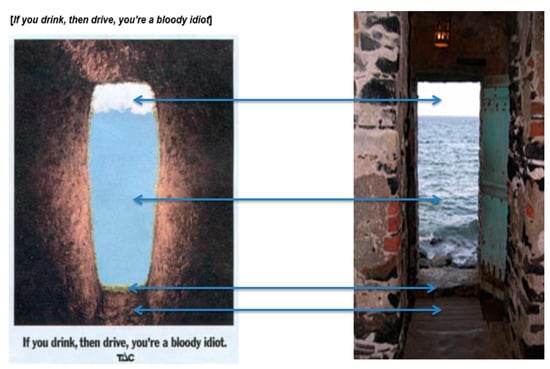
Figure 6.
Australian TAC Poster Vs. The Senegalese Door of No Return. Public Service Poster for the Transport Accident Commission (TAC), Australia. Door photo by Willem Proos (courtesy of travelpicturesgallery.com).
Since that childhood trip to Gorée, the image of the Door of No Return has haunted me. It comes to mind in radically different contexts and occasions. I see its outline in places surprisingly dissimilar. In December 2018, during my latest trip to Senegal, I attended a conference at Université Cheikh Anta Diop, Dakar’s most prestigious university. For the first time, in front of a Senegalese audience, I spoke of the Door of No Return and its symbolisms. And I asked if others experienced it similarly, as a haunting presence. My intuition was confirmed: It is, indeed, an image that we carry within us, defining us as Senegalese.
The haunting continues, I should add. When in Toronto in August 2019, I visited Niagara Falls with my family. (See Figure 7) Under “Horseshoe Falls”—the Canadian side of Niagara—we did the touristy thing and took the tour, “The Journey Behind the Falls.” Tunnels have been carved through the bedrock under the falls. There is a portal cut straight through the rock, allowing one to stand behind the falls; from there, one has a breathtaking view of the rush of water crashing down. Walking down that tunnel leading to that “doorway” portal reminded me of the Door of No Return. How could it not? (See Figure 8) Certainly there is no return from this portal, should one pass through it to the water falling from above. The power of the falls is said to be monstrous, brutal and heavy enough to crush bones. The image is fascinating and frightening, just as the sound of the water is deafening.
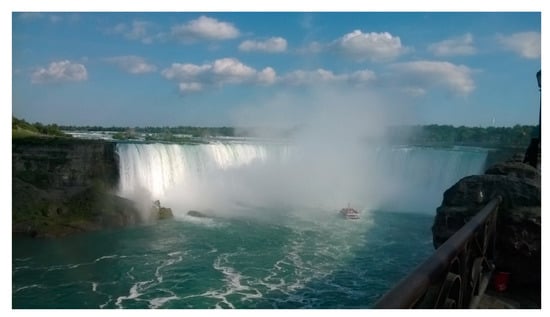
Figure 7.
Niagara Falls, Canadian Side. Wikimedia Commons (photo by Cjsinghpup).
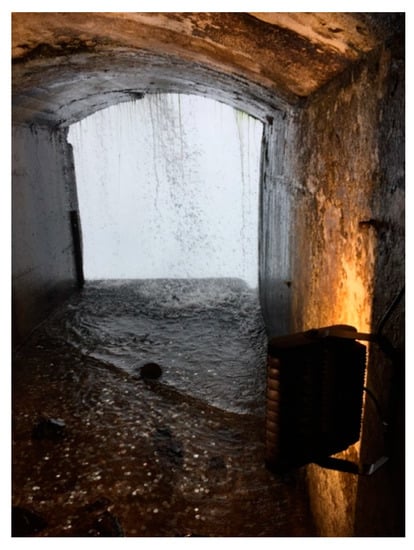
Figure 8.
“Behind Niagara Falls” (photo by Dalla Malé Fofana).
Perhaps my fascination with portals is mythic—archetypal in the Jungian sense—in which case, my cultural experience reflects a “collective memory” belonging to the human species. I am reminded of the common phrase, “light at the end of the tunnel.” In an article, “There Are Seven Types of Near-Death Experiences” (MacDonald 2015), Fiona MacDonald cites the work of Sam Parnia, director of resuscitation research at Stony Brook University School of Medicine. The testimonies of people who have been brought back to life after suffering fatal accidents are thematically consistent, according to Dr. Parma: Many imagine themselves moving through a tunnel, at the end of which is a brilliantly shining light (see Figure 9). Mythically, symbolically, we are beckoned to a gateway-passage leading to an unknowable but inevitable void. Whether this mental image has spiritual or medical origins is irrelevant: The point is that the tunnel, portal, and light form as real an experience as any other mental or physical event undergone by survivors of near-death. And, typically, it is a world-changing experience, forever changing a person’s understanding and expectations of life and death.
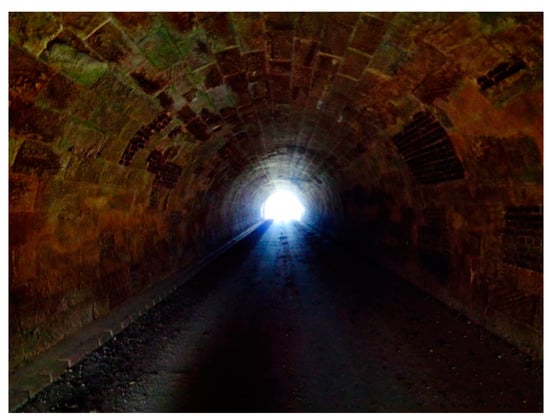
Figure 9.
“Light at the End of the Tunnel.” Wikimedia Commons (photo by Stiller Beobachter).
Returning from archetypal psychology to Senegalese history: Passage through the Door of No Return certainly meant death. It was physical death for many, as millions of Africans died from the bad conditions of prison houses and the prison ships transporting them to the Americas. But it was a death of self-identity for all, as once-free men and women were turned into slaves; and, if they survived the passage, their New World “home” would be one of brutal treatment and ceaseless, backbreaking toil. The enslaved Africans were typically renamed by white owners, which could result in them losing everything: name, family, religions, language, all.
The testimonies of black people who participated to the 1956 Paris Conference—attended by black personalities from around the world—showed how wide and deep the wounds of diaspora have been. The Conference celebrated the solidarity of a people united by ancestral origins and skin color and common experience. The “Back to Africa” movement was founded at this time. While Senegalese Africans still suffered under colonial rule (independence from France would come in 1960), the world’s Africans were looking back to the place of their origins. What they were seeking was not a physical place merely but the meaning—the mythos—of that place. It is the linguistic, historical, social, psychological, and mythic unity of Senegalese ethos to which I now turn.
5. Returning to Gorée
About the time the King’s soldiers came, the eldest of these four sons, Kunta, when he had about 16 rains, went away from his village to chop wood to make a drum … and he was never seen again …—Tribal story as told to Alex Haley ((Haley 1972), “My Furthest,” p. 12)
In contrast to modern notions of the person or self, [classical] ethos emphasizes the conventional rather than idiosyncratic, the public rather than the private. The most concrete meaning given for the term [ethos] in the Greek lexicon is “a habitual gathering place,” and I suspect that it is upon this image of people gathering together in a public place, sharing experiences and ideas, that its meaning as character rests.—S. Michael Halloran, “Aristotle’s Concept of Ethos” (Halloran 1982, p. 60)
There is ethos in naming. To name is to assert power, ownership: We see this in the renaming of slaves (as Kunta Kinte’s white master presumably renamed him Toby—a “fine” English working-class moniker). We see this in places, as well. In its history of colonization (Ginio 2008), the Portuguese named it Ila de Palma. The Dutch renamed it Good Rade. Under French rule, it became Gorée. The meaning of that name could illustrate its strategic location. With the slave trade’s transit points reaching from the northwest tip of the continent down to The Gambia, Senegal sat right in the center of the trade. Reaching out into the Atlantic, the Dakar archipelago is the nearest point on the continent to the Americas. Some kilometres farther west sits the island whose harbor offered safe haven for anchoring ships: hence the name Good Rade (UNESCO/NHK 2019). But if the name suggests its excellent location for slave traders, it certainly was the opposite for the Africans who were brought there in chains, to await their passage6.
From a linguistic perspective, it is easy to see how Good Rade becomes Gorée. Consonant clusters are an unusual pattern in wolof, which would explain how the cluster “d” and “r” in (Goo)d+R(ade) would be simplified. Wolof language is also unfamiliar with closed syllables: The final consonant “d,” which ends the word rade, and the neutral ending of /reid/ would turn the sound /reid/ turns into /re/. I should admit that the origin of the word Gorée has been well studied. But, for Senegalese, the word bears another symbolic meaning as sustained by wolof language. Indeed, the word goree /gɔre/ does exist in wolof and is polysemic, /gɔre/ being an adjective that refers to the quality of a person who is physically free (as opposed to being a slave); at the same time, it designates a person who has high and noble values. If we take a close look at its variants, the word /gor/ refers to “man,” “manhood,” and “courage.”7 As a verb, it refers to the idea of cutting-loose with violence, or separating an element from where it belongs, the way one would chop a branch from a tree (N’diaye-Correard and Schmidt 1979; Ndao 2002).
Though a small island of 28 hectares and 1300 inhabitants (N’diaye 2006), Gorée personifies the African slave trade. It is, in effect, a “memory island,” symbolic of the slave trade and its suffering. Its strategic location made Gorée “the centre of the rivalry between European nations for control of the slave trade” (UNESCO/NHK 2019). Though I have focused on la Maison des Esclaves, the island is said to have held more than a dozen slave houses, among which was “the Castle, a rocky plateau covered with fortifications which dominate the Island,” and the Relais de l’Espadon, former residence of the French governor” (UNESCO/NHK 2019). Clearly, the island’s past belongs to its present. If its ethos is to heal, the mythos of the island must move beyond trauma. It can do so by becoming a site of remembrance and reflection, as well as of reconciliation: “The Island of Gorée is now a pilgrimage destination for the African diaspora, a foyer for contact between the West and Africa, and a space for exchange and dialogue between cultures through the confrontation of ideals of reconciliation and forgiveness” (BBC News 2007).
I find hope in the BBC News article cited above, but also find it a bit optimistic: In these many respects, Gorée remains a work-in-progress. Though its role in the slave trade is regularly questioned by some, there have been moments of formal commemoration. In 1944, the colonial administration listed Gorée as a historic site. It was placed on Senegal’s National Heritage List in 1975 and on the World Heritage List in 1978 (BBC News 2007). And foreign dignitaries have come to pay their respects, none more welcome than the 2013 visit of U.S. President Barack Obama and his wife Michelle (see Figure 10). Current ordinances regulate new construction, ensuring that historic sites are well preserved and protected. There are no private automobiles. With its colonial-style buildings, rural flavor and lack of traffic noise, crossing the ocean to Gorée feels like crossing a time barrier—quite the opposite of Dakar, the busy, noisy, hectic capital city of Senegal.
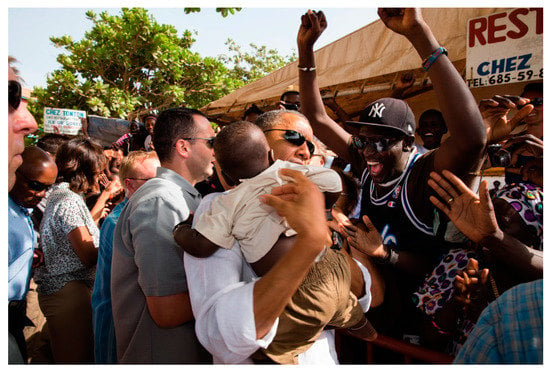
Figure 10.
Barack Obama Greeted by Gorée Islanders. (Official White House photo by Pete Souza).
6. Conclusions: Healing the Wounds of Colonialism
Ku xam’ul fa nga jëm dellu fa nga jugé (He who doesn’t know where he is heading toward should go back to where he is from).—Wolof proverb
None of us lives without a history; each of us is a narrative. We’re always standing some place in our lives, and there is always a tale of how we came to stand there, though few of us have marked carefully the dimensions of the place where we are or kept time with the tale of how we came to be there.—Jim W. Corder, “Argument as Emergence, Rhetoric as Love” (Corder 1985, p. 16)
The future of Senegal lies in facing our wounds and haunts, instead of repressing them and running away. We need to speak them, sing them, write about them, turning them into art. There are lessons to learn from the history of the slave trade. But that is only a start: We must face the broader history of colonialism, if we are to evolve toward a more prosperous, just, hopeful future.
We cannot simply erase a half-century of African colonization (Ross 2007). The case of Senegal might be harder than other states regionally, since Dakar was the capital city of AOF (French West Africa) and Senegal enjoyed some special privileges, compared to other colonies. Thus, Senegal was among those former colonies that did not fight hard for independence. After the colonizers left in 1960, Senegalese political leaders continued to look to France for guidance. Their children studied abroad, becoming not cosmopolitan so much as Europeanized. This led Franz Fanon to write his Peau noir masque blancs (Fanon 1952): “Black Skin, White Masks.”
Is the modern Senegalese ethos politically and culturally “independent,” or is it colonized, still? An inferiority complex remains: We seem to suffer from what Marley (Bob Marley and the Wailers 1980) called “mental slavery”—a habit of looking to Europe for standards and terms of “progress.” Economically, the most flagrant symbol of “mental slavery” is the West African currency Franc CFA, which is under French government control (Sylla 2017). If the nation’s political leaders remained Eurocentric in orientation, its spiritual leaders quickly broke free from mental domination. Following in the footsteps of India’s Mahatma Gandhi and America’s Martin Luther King, Jr., Senegal’s spiritual leaders understood the futility of violence; instead, they practiced—successfully—the principles of nonviolent civil disobedience. The French colonial authorities had little difficulty dealing with political upstarts. It was people like Ahmadou Bamba and El Hadji Malick Sy who confused them, posing the biggest challenges. As Sufi Muslims, they practiced (and preached) a religion of unity, peace, contemplation, and resilience. Their spiritual work ensured that Senegal remained a peace-loving and peace-seeking nation—one of the very few in Africa never to have known or witnessed civil war or major cycles of violence (Fofana 2015).
There is an aspect of Senegalese ethos that I have hinted at but not yet noted explicitly: As much as land, our life belongs to the sea—which is not always a friendly companion. Even today, Gorée island is not of easy access. The Atlantic Ocean acts like a barrier to cross, and it takes a ferry to get there. Deep water holds mystery for African polytheist former generations. And, even now, there are periodic incidents of fishermen “taken” by the sea, which keeps alive the myth of Mamy wata (mommy water). The tragedy of the ferry Le Joola only increases this myth. Le Joola was a Senegalese government-owned ferry that capsized off the coast of The Gambia on 26 September 2002. This “loss of an estimated 1800 lives [is] recognised as one of Africa’s worst-ever maritime disasters,” being “the second-worst non-military disaster in maritime history” (Barry 2003). Nevertheless, younger generations tend to give less consideration to these traditional fears. As proof, we could point to the number of young people who die in the sea (a death toll of 40 yearly) between June to October, when schools are closed. Young people spend a lot of time on the beach—without learning how to swim properly (Agence France Press 2018).
Poignantly, economic stresses have led to a modern exodus of Africans, who cross the Mediterranean as illegal immigrants in hopes of reaching more affluent European shores (Gueye 2006). Their poverty is reflected in the life rafts and small, unseaworthy vessels that they crowd into, desperate for a better life. The year 2006 was especially bad for young Senegalese, who left West Africa in wooden pirogues, headed for Italy and Spain (Fofana 2017). Barca wala barzakh was their motto: Faced with unbearable poverty, they chose Barça (Barcelona), or Barzakh (death). Senegalese film director Moussa Dieng Kala (Mbaye 2006) asked one of the illegal immigration survivors, “Are you aware that by boarding in wooden pirogues from Senegal to Spain, you are committing suicide?” He was answered, “How can a person who is already dead commit suicide?” (APA News 2006). Over the past decade, thousands of sub-Saharan Africans, many Senegalese, have drowned in this attempt. Indeed, even as I was penning this paper, there are reports of people dying at sea, trying to reach Spain. Of course, poverty remains great in Africa. The allure of European emigration, illegal or otherwise, feeds the myth of a European paradise vs. an African wilderness. This myth reinforces the African inferiority complex.8 Put simply: For most who risk life at sea, the expectations of a better life prove a false hope. (What kind of welcome can an illegal immigrant expect?).
Still, not all stories of the ocean end in tragedy. Every summer, the annual Dakar-Gorée Swimming Race is held, organized between the capital city of Dakar and Gorée Island. The region’s best come to compete in this well-publicized event. To swim competitively in this 5.2 km race requires both speed and endurance. Paradoxically, the annual Traversée Dakar-Gorée serves to shorten the distance between city and island, creating solidarity. True, the slaves who tried to escape by swimming could not have made it, given their chains and the 5 kg cast-iron ball attached to their feet—or to their necks. Still, “it’s not just a swim race,” as Haque (Haque 2018) writes: “it’s a tribute to those who remain defiant, refusing their fate as slaves and instead swimming for freedom. [It is] a celebration of freedom and resistance and of the human spirit’s ability to overcome adversity.” On that positive note, I end this essay.
Funding
This research received no external funding.
Conflicts of Interest
The author declare no conflicts of interest.
References
- Agence France Press. 2018. Quarante noyades en plages interdites à la baignade à Dakar. VOA Afrique. Available online: https://www.voaafrique.com/a/noyades-en-deux-mois-dans-des-plages-interdites-%C3%A0-la-baignade-%C3%A0-dakar/4509324.html (accessed on 2 September 2018).
- APA News. 2006. 2006 a été une “Année charnière” pour le Sénégal. IC/ib/APA. Available online: https://www.seneweb.com/news/Politique/2006-a-t-une-ann-e-charni-re-pour-le-s-n-gal_n_7604.html (accessed on 2 September 2019).
- Attenborough, Richard. 1982. Gandhi. Screenplay by John Briley. Culver City: Columbia Pictures. [Google Scholar]
- Attenborough, Richard. 1987. Cry Freedom. Screenplay by John Briley. Los Angeles: Universal Pictures. [Google Scholar]
- Barry, Jessica. 2003. Senegal Ferry Disaster Reveals Need for Psychological. The International Federation of Red Cross and Red Crescent Societies. Available online: https://www.ifrc.org/en/news-and-media/news-stories/africa/senegal/senegal -ferry-disaster-reveals-need-for-psychological-support/ (accessed on 2 September 2018).
- Baumlin, James S., and Tita French Baumlin. 1994. On the Psychology of the Pisteis: Mapping the Terrains of Mind and Rhetoric. In Ethos: New Essays in Rhetorical and Critical Theory. Edited by James S. Baumlin and Tita French Baumlin. Dallas: Southern Methodist University Press, pp. 91–112. [Google Scholar]
- Baumlin, James S., and Craig A. Meyer. 2018. Positioning Ethos in/for the Twenty-First Century: An Introduction to Histories of Ethos. Humanities 7: 78. [Google Scholar] [CrossRef]
- BBC News. 2007. The Slave Trade. Available online: http://news.bbc.co.uk/2/hi/africa/6445941.stm#sa-link_location=more-story-2&intlink_from_url=https%3A%2F%2Fwww.bbc.com%2Fnews%2Fworld-africa-23078662&intlink_ts=1572437957176&story_slot=1-sa (accessed on 2 September 2018).
- Bob Marley and the Wailers. 1980. Redemption Song. In Uprising. Kingston: Tuff Gong. [Google Scholar]
- Bouchareb, Rachid. 2001. Little Senegal. Screenplay by Rachid Bouchareb and Olivier Lorelle. Berlin: 3B Productions et Taunus Film. [Google Scholar]
- Brown, Julian. 2016. The Road to Soweto: Resistance and the Uprising of 16 June 1976. Auckland Park: Jacana Media. [Google Scholar]
- Cassel, Eric J. 1982. The Nature of Suffering and the Goals of Medicine. New England Journal of Medicine 306: 639–45. [Google Scholar] [CrossRef] [PubMed]
- Chomsky, Marvin J. 1977. Roots. Screenplay by Alex Haley. New York: ABC Television. [Google Scholar]
- Corder, Jim W. 1985. Argument as Emergence, Rhetoric as Love. Rhetoric Review 4: 16–32. [Google Scholar] [CrossRef]
- Fanon, Frantz. 1952. Peau noir Masque Blancs. Paris: Les Éditions du Seuil. [Google Scholar]
- Fixico, Donald. 2003. The American Indian Mind in a Linear World: American Indian Studies and Traditional Knowledge. Abingdon-on-Thames: Taylor & Francis Group. 207p, ISBN (Print)0415944562, 9780203954621. [Google Scholar]
- Fofana, Dalla Malé. 2015. La subjectivité journalistique en entrevue médiatique: une approche rhétorique et interactionnelle de l’émission Péncum Sénégal. Lettres et sciences humaines. Moissonnage: Collection moissonnée par Bibliothèques et Archives Canada. Available online: http://hdl.handle.net/11143/7712 (accessed on 18 November 2018).
- Fofana, Dalla Malé. 2017. Perspectives et retour sur le drame de l’émigration clandestine. Blogspot. Available online: http://dallamalefofana.blogspot.ca/2017/02/perspective-et-retour-sur-le-drame-de.html (accessed on 10 September 2018).
- Ginio, Ruth. 2008. French Colonialism Unmasked: The Vichy Years in French West Africa. Library of Congress. Nebraska: University of Nebraska Press. 264p, ISBN-10 0803217463. [Google Scholar]
- Gueye, M. 2006. Un dispositif pour freiner les clandestins: Les pays d’Europe surveillent le Sénégal et la Mauritanie. Le Quotidien. Available online: http://archives.e-mauritanie.net/mauritanie-detail_la_une.php?p=2919 (accessed on 20 September 2018).
- Haley, Alex. 1972. My Furthest-Back Person—“The African”. New York Times. Section M. p. 12. Available online: https://www.nytimes.com/1972/07/16/archives/my-furthestback-personthe-african.html (accessed on 18 September 2018).
- Haley, Alex. 1976. Roots: The Saga of an American Family. New York: Doubleday. [Google Scholar]
- Halloran, S. Michael. 1982. Aristotle’s Concept of Ethos, or If Not His Somebody Else’s. Rhetoric Review 1.1: 58–63. [Google Scholar] [CrossRef]
- Haque, Nicolas. 2018. Hundreds swim to former Senegal slave island in annual race. Aljazeera. October. Available online: https://www.aljazeera.com/news/2018/10/hundreds-swim-senegal-slave-island-annual-race-181001080334142.html (accessed on 17 November 2018).
- Hébert, Louis. 2011. Les fonctions du langage. Signo. Available online: http://www.signosemio.com/jakobson/fonctions- du-langage.asp (accessed on 20 September 2018).
- Letort, Delphine. 2014. Rethinking the Diaspora through the Legacy of Slavery in Rachid Bouchareb’s Little Senegal. Black Camera 6.1 (Fall 2014): 139–53. [Google Scholar] [CrossRef]
- Lloyd, Nick. 2011. The Amritsar Massacre: The Untold Story of One Fateful Day. London: (Anglais) I. B. Tauris. [Google Scholar]
- Macdonald, Fiona. 2015. There Are Seven Types of Near-Death Experiences, According to Research. Sciencealert. Available online: https://www.sciencealert.com/there-are-seven-types-of-near-death-experiences-according-to- new-research (accessed on 10 September 2018).
- Mbaye, Massamba. 2006. Moussa dieng kala, réalisateur d’un film sur l’émigration clandestine: “Les jeunes candidats au voyage me disent qu’ils sont déjà morts’’. Yekini. Available online: https://www.seneweb.com/news/Societe/moussa-dieng-kala-r-alisateur-d-un-film-sur-l-migration-clandestine-les-jeunes-candidats-au-voyage-me-disent-qu-ils-sont-d-j-morts_n_5570.html (accessed on 20 December 2018).
- Meyer, Craig A. 2019. From Wounded Knee to Sacred Circles: Oglala Lakota Ethos as “Haunt” and “Wound”. Humanities 8: 36. [Google Scholar] [CrossRef]
- Mourre, Martin. 2017. Thiaroye 1944. Histoire et Mémoire d’un Massacre Colonial. Presses Rennes: Universitaires de Rennes. [Google Scholar]
- N’diaye, Joseph. 2006. Il fut un jour à Gorée... L’esclavage raconté aux Enfants. Neuilly-sur-Seine: Michel lafon. [Google Scholar]
- N’diaye-Correard, G., and J. Schmidt. 1979. Le français au Sénégal, Enquête Lexicale. Dakar: Université de Dakar. [Google Scholar]
- Ndao, P. Alioune. 2002. Le Français au Sénégal: Une approche polynomique. Sudonline 1. Available online: http://www.sudlangues.sn/spip.php?article42 (accessed on 3 September 2018).
- Reynolds, Nedra. 1993. Ethos as Location: New Sites for Understanding Discursive Authority. Rhetoric Review 11: 325–38. [Google Scholar] [CrossRef]
- Ross, Will. 2007. Slavery’s long effects on Africa. BBC News, March 29. [Google Scholar]
- Sembène, Ousmane. 1988. Camp de Thiaroye. Paris: Enaproc and Société Nouvelle Pathé Cinéma. [Google Scholar]
- Sylla, Ndongo Samba. 2017. The CFA Franc: French Monetary Imperialism in Africa. Blog Editor. Available online: https://blogs.lse.ac.uk/ (accessed on 20 September 2018).
- Transport Accident Commission. 1989. If you drink, then you drive, you’re a bloody idiot, Australia. Available online: https://www.tac.vic.gov.au/ (accessed on 18 September 2018).
- UNESCO/NHK. 2019. Island of Gorée. Unesco World Heritage Centre. Available online: https://whc.unesco.org/en/list/26/ (accessed on 20 September 2018).
| 1 | School trips to Gorée Island in Senegal at that time were not institutionalized. The consequence of this lack of formality is that we did not even make a phone call or register for a guided tour of the House. Moreover, we failed to show up in time for one of the daily visits. The only sneak peek some of us (the most insistent ones) could have of the place was under the pressure of a security guard who finally let us in for a very short while. A small group of two boys and three girls who came back after the big group moved away and implored on the brink of tears for the clemency of the security guide. It was July 1990. So, we obviously did not see Joseph Ndiaye, but his voice resonated in our ears in the way he would usually narrate the tragedy in that fashion that is so well rooted in the African traditional storytelling. |
| 2 | It might be somewhat puzzling for some readers to notice that I did not/could not go back to the House of Slaves, given how important it reveals itself to be for me. But one thing to bear in mind is that going back to Senegal for a month or less is a hectic experience for many of us, not compatible with the poise needed to go to that place for a proper self-examination. Back to Senegal for that short time, one literally sinks in urgent material needs as well as in concerns that have to do with families and relatives. As a matter of fact, even the locals do not feel the need to go to Gorée (repeatedly). They feel that struggling to cope with everyday life and economic problems is more relevant. Such daily hardships make a visit to Gorée a secondary concern. Besides, it is important to point out that in Africa, we do not have the culture of travelling from a place to another for sightseeing (to see “things”). We would rather do that to meet or visit relatives. As an example, most Senegalese have never been to the local zoo. On the other hand, the paradigm of Gorée Island is not a subject of common discussion in the media. The discussed topics are rather the current economic and political situation which is presented as linked to government’s actions rather than to a more remote event. Many consider relating the current situation to the Slave Trade is taking a fatalist stance. The House of Slaves therefore attracts far more foreign tourists along with diaspora, slave-descendant Black Americans than African locals. In fact, they make us remember. Coverage of high-profile visitors to the House of Slave is the only occasion for this part of our history to be mentioned in the media. And we would again see Joseph Ndiaye and hear again his firm and strong voice re-telling his well-known narration that educated locals know so well even without having been there. |
| 3 | Meyer’s original reads: To understand Oglala Lakota ethos today, one must understand the importance of the experience of this massacre, which extends to the visuals, the emotions, the memories of the scene—that is, to the entire experience (Fixico 2003, p. 22). It is the mythos of the massacre that we must seek to understand. For the EuroAmerican bystander, it is easy to dismiss the Wounded Knee Massacre as having happened over 100 years ago to some group at some place; it is markedly different if one’s cultural identity rests in a continual retelling—in effect, a reliving—of the Massacre. As Donald L. Fixico writes, “When retold, the experience comes alive again, recreating the experience by evoking the emotions of listeners, transcending past-present-future. Time does not imprison the story” (Fixico 2003, p. 22). The telling of these stories forms an integral part of Oglala ethos, both as-haunt and as-wound. (Meyer 2019, p. 4) |
| 4 | Again, Meyer’s original: Both the place and the events of the massacre haunt the Lakotan cultural memory, which rests in the collective experience of trauma and the place—the physical haunt—of its occurrence. As such, an Oglala Lakota ethos derives from haunt and wound. Ethos-as-haunt demonstrates how location constitutes a people, its culture, traditions, stories, and history…. Simply put, the events that occur on a parcel of land lends it character to the people on that land…. With this summary of the Wounded Knee Massacre as a starting point, I turn now to review the Western model of ethos and its potential as haunt. From this understanding of location, I suggest a bridge between haunt and wound as it relates to an Oglala Lakota ethos and the hopeful healing that can take place through an acknowledgement of that woundedness. The conclusion offers insight into Oglala wisdom for the Westernized humanities and the possibility of healing the wound from two different perspectives: EuroAmerican and Oglala. (Meyer 2019, p. 5) |
| 5 | Referring to Roots leads us to the Algerian film Little Senegal directed by Rachid Bouchareb (Bouchareb 2001). The theme of the movie is somewhat the opposite of Haley’s Root in the sense that the character Alloune (Sotigui Kouyaté), a tour guide at a Senegalese slave museum decided to go to America to live another more experimental dimension of the deportation, after the theoretical narration of the lave trade and the vision of a common origin. This would make him come to terms with the various realities of how African descendants feel and consider their past. He could experience the problem that we refer to with the 1956 Paris Congress of Black Writers and Artists in 1956 (see later). That trip reveals itself to be a true challenge to an “idealized view of the diaspora”, and an experience of “the real and imagined community relationship among dispersed populations” (Letort 2014, p. 142). |
| 6 | We cannot talk about Gorée Island without mentioning divergent historical readings (for further details, see Philip D. Curtin or David Eltis) of the slavery past at Gorée Island. For some historians, there is lack of requisite evidence for the House of Slaves to be considered an official site of slave deportation. Questions are indeed raised about the actual number of slaves deported or about the shoreline being possibly too rocky or not deep enough for ships to dock near the fort. These questions are certainly important for historians and specialists who need more measurable facts for the site to be considered either a cultural or a historical symbol. But African locals totally ignore and dismiss polemics and claims about the minor role (if any) of the House of Slave in the African slave trade. They consider those claims as attempts to erase this so iconic print of a crime on Mankind. In a way, they experience the same feeling as Jews in front of claims that deem Shoah to be fabricated despite many formal evidence. For Africans, since the slave trade is factual and the House of Slaves a physical symbol that connects them to its atrocities, then they would not wonder at all about how important the role it played into it. |
| 7 | Curiously, this mirrors the etymology of English “virtue,” where the Latin virtus—meaning nobility of character—derives from vir, for “man.” Hence, virtus is the quality of high and noble character associated with “manliness.” |
| 8 | Again, the myth of European superiority is real, though its expressions are often subtle. I have already mentioned political leaders who keep replicating policies dictated form Europe. We consume European entertainments—films especially—rather than make our own. And even sadder, in my opinion, are the many black Africans, women mostly, who resort to chemical products to lighten their skin. The effects of colonialism remain with us, still. |
© 2020 by the author. Licensee MDPI, Basel, Switzerland. This article is an open access article distributed under the terms and conditions of the Creative Commons Attribution (CC BY) license (http://creativecommons.org/licenses/by/4.0/).